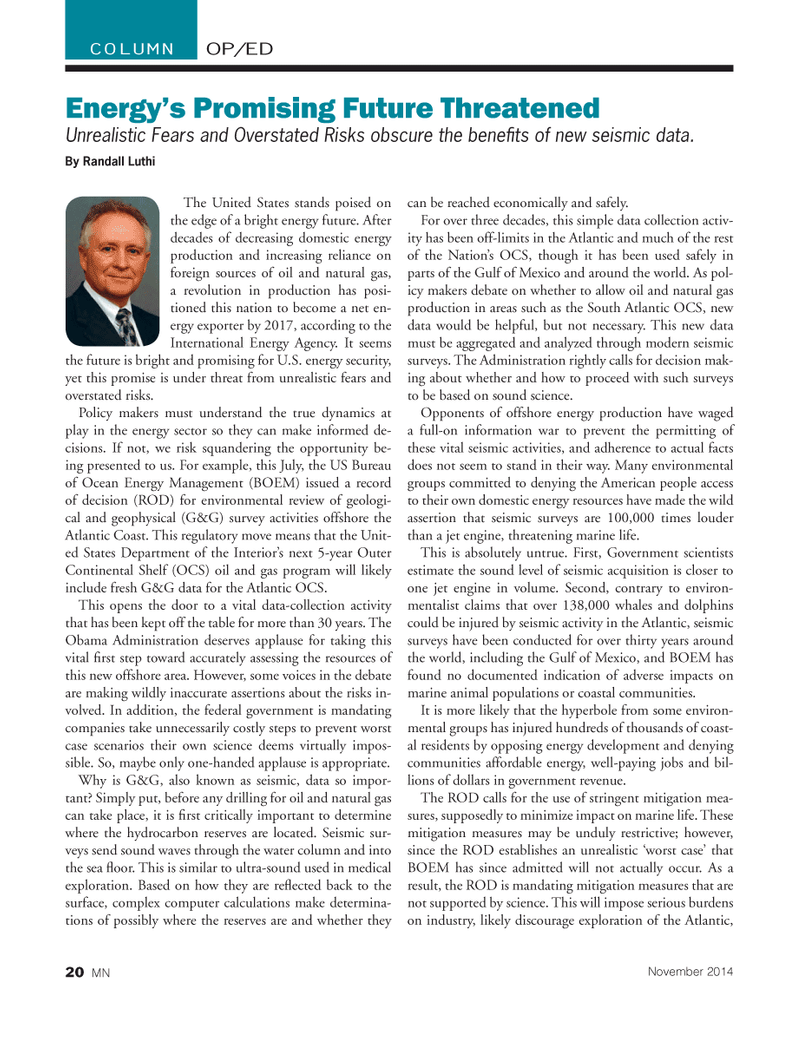
Page 20: of Marine News Magazine (November 2014)
Workboat Annual
Read this page in Pdf, Flash or Html5 edition of November 2014 Marine News Magazine
The United States stands poised on the edge of a bright energy future. After decades of decreasing domestic energy production and increasing reliance on foreign sources of oil and natural gas, a revolution in production has posi- tioned this nation to become a net en- ergy exporter by 2017, according to the
International Energy Agency. It seems the future is bright and promising for U.S. energy security, yet this promise is under threat from unrealistic fears and overstated risks.
Policy makers must understand the true dynamics at play in the energy sector so they can make informed de- cisions. If not, we risk squandering the opportunity be- ing presented to us. For example, this July, the US Bureau of Ocean Energy Management (BOEM) issued a record of decision (ROD) for environmental review of geologi- cal and geophysical (G&G) survey activities offshore the
Atlantic Coast. This regulatory move means that the Unit- ed States Department of the Interior’s next 5-year Outer
Continental Shelf (OCS) oil and gas program will likely include fresh G&G data for the Atlantic OCS.
This opens the door to a vital data-collection activity that has been kept off the table for more than 30 years. The
Obama Administration deserves applause for taking this vital fi rst step toward accurately assessing the resources of this new offshore area. However, some voices in the debate are making wildly inaccurate assertions about the risks in- volved. In addition, the federal government is mandating companies take unnecessarily costly steps to prevent worst case scenarios their own science deems virtually impos- sible. So, maybe only one-handed applause is appropriate.
Why is G&G, also known as seismic, data so impor- tant? Simply put, before any drilling for oil and natural gas can take place, it is fi rst critically important to determine where the hydrocarbon reserves are located. Seismic sur- veys send sound waves through the water column and into the sea fl oor. This is similar to ultra-sound used in medical exploration. Based on how they are refl ected back to the surface, complex computer calculations make determina- tions of possibly where the reserves are and whether they can be reached economically and safely.
For over three decades, this simple data collection activ- ity has been off-limits in the Atlantic and much of the rest of the Nation’s OCS, though it has been used safely in parts of the Gulf of Mexico and around the world. As pol- icy makers debate on whether to allow oil and natural gas production in areas such as the South Atlantic OCS, new data would be helpful, but not necessary. This new data must be aggregated and analyzed through modern seismic surveys. The Administration rightly calls for decision mak- ing about whether and how to proceed with such surveys to be based on sound science.
Opponents of offshore energy production have waged a full-on information war to prevent the permitting of these vital seismic activities, and adherence to actual facts does not seem to stand in their way. Many environmental groups committed to denying the American people access to their own domestic energy resources have made the wild assertion that seismic surveys are 100,000 times louder than a jet engine, threatening marine life.
This is absolutely untrue. First, Government scientists estimate the sound level of seismic acquisition is closer to one jet engine in volume. Second, contrary to environ- mentalist claims that over 138,000 whales and dolphins could be injured by seismic activity in the Atlantic, seismic surveys have been conducted for over thirty years around the world, including the Gulf of Mexico, and BOEM has found no documented indication of adverse impacts on marine animal populations or coastal communities.
It is more likely that the hyperbole from some environ- mental groups has injured hundreds of thousands of coast- al residents by opposing energy development and denying communities affordable energy, well-paying jobs and bil- lions of dollars in government revenue.
The ROD calls for the use of stringent mitigation mea- sures, supposedly to minimize impact on marine life. These mitigation measures may be unduly restrictive; however, since the ROD establishes an unrealistic ‘worst case’ that
BOEM has since admitted will not actually occur. As a result, the ROD is mandating mitigation measures that are not supported by science. This will impose serious burdens on industry, likely discourage exploration of the Atlantic,
OP/EDCOLUMN
Energy’s Promising Future Threatened
Unrealistic Fears and Overstated Risks obscure the benefi ts of new seismic data.
By Randall Luthi
November 2014 20 MN
MN Nov14 Layout 18-31.indd 20 10/23/2014 10:22:29 AM

 19
19

 21
21
